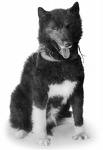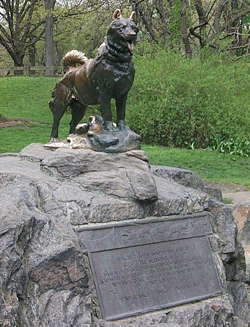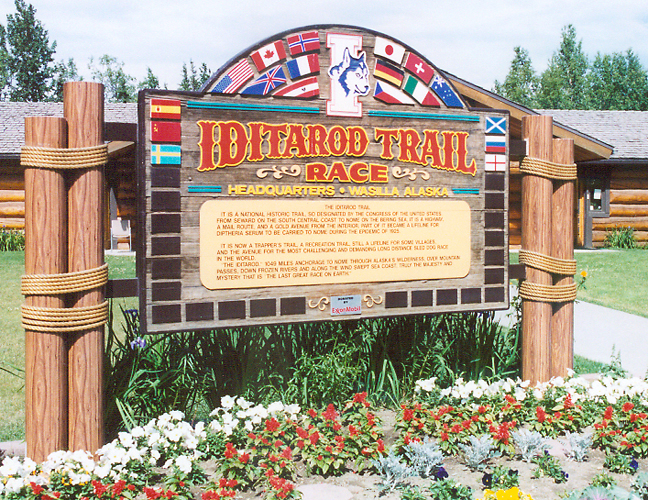This eFLYER was developed in HTML for viewing with Microsoft Internet Explorer while connected to the Internet: View Online.
To ensure delivery to your inbox, please add eFLYER@barnstormers.com to your address book or list of approved senders. |
 |
ISSUE
110 - March 2010
Over 8,000 Total Ads Listed
1,000+ NEW Ads Per Week
|
| Heroes |
By David Rose
San Diego, California |
They ran the Iditarod this week. You
know, bundle up, hook up the dogs and race 1049+ miles across
Alaska.
Lance Mackey won it, again, for his fourth straight
time. Hans Gatt managed second and Jeff King third.
So when
I saw the news story covering it, my question was why? Sure,
it’s great to get out there and race your car, airplane,
horse, or even your dogsled. But my question was why 1049+
miles over 8 or 9 days in the dead of the freezing winter?
And why does it run from Anchorage (Willows actually) to Nome? |
|
 Finding
out why drew me in to one of those special stories, common
knowledge to some, but totally unknown to the rest of us. Finding
out why drew me in to one of those special stories, common
knowledge to some, but totally unknown to the rest of us.
First
you have to appreciate what winter meant in Nome Alaska in
1924 (picture left, Nome in Winter). It literally
closed the town to the outside world. The harbor froze out
shipping, snow and ice covered the roads, completely closing
them and the airplanes of 1924 never challenged the constant
blizzard conditions. In winter the town and the surrounding
Inuit villages were as isolated from the rest of the world
as the moon.
 Which
was fine, most of the time. In normal circumstances the residents
coped well. They kept in contact with one another; checked on
the neighbors; stayed aware of who came and went (picture
right, Front Street in Nome, Alaska). Which
was fine, most of the time. In normal circumstances the residents
coped well. They kept in contact with one another; checked on
the neighbors; stayed aware of who came and went (picture
right, Front Street in Nome, Alaska).
But in that
winter of 1924, something else had joined them. Just a cold most
thought, or influenza at worst. Sore throats, a little cough,
a little fever, some dizziness; the common cold was spreading
through town. Or so it seemed to Dr. Curtis Welch. But by early
January Dr. Welch, who essentially represented all of Nomes medical
care, began to think his diagnosis of the common cold might bear
a second thought. Weeks had passed and the little epidemic wasn't
abating as it should have. |
Dr. Welch came to realize that this had
to be Diphtheria. Highly contagious, symptoms identical to
the common cold. Bad cases of Diphtheria lead to liver and
heart failure and the patient dies.
Still, not a problem, once
it’s properly diagnosed medications deal with it quit
well. Diphtheria antitoxins cure it and there were thousands
of units available; until they discovered the antitoxins were
out of date; expired the year before and now potentially lethal.
In desperation Dr. Welch telegraphed the US Health Service
and they were able to track down 30,000 units of the Diphtheria
antitoxin in Anchorage. But Anchorage! It lay 600 miles as
the crow flys across the most forbidding winter landscape on
the planet. |
Dogsleds
would be the only way. But impossible. Not in the dead of winter.
Not over these mountainous, freezing, utterly barren landscapes.
Plus the the antitoxin was packaged in fragile glass phials
and if they didn’t break the serum could freeze on the
way. They had to try. Wrapping the phials in fur against the
cold, they padded them as best they could. From the rail station
in Anchorage they traveled by train 200 miles north to Nenana.
But from Nenana, the little 20 pound package of antitoxin was
still 675 miles across sub-zero wasteland from Nome.
Impossible.
A desperate attempt to deliver the antitoxin and save the villages
had to be made by dogsled. Here the telegraph proved to be
their godsend as with it they were able to line up relief teams
all along the way to relay the serum.
 So why do I bring this
up here on an aircraft site? Because if you’ve followed
many of my stories in past Eflyers you know I like to write
about heroes and it took a lot of heroism to save the people
living around Nome that winter. So why do I bring this
up here on an aircraft site? Because if you’ve followed
many of my stories in past Eflyers you know I like to write
about heroes and it took a lot of heroism to save the people
living around Nome that winter.
The attempt to save them involved
no fewer than twenty mushers and 150 courageous dogs. They
would mush 24 hours a day for eight days, all day, all night.
The teams would face minus 75 degree weather and winds so high
they would actually blow the sleds over. Finally, Gunner Kassden,
behind 12 Huskies and the lead dog Balto, having covered the
final 54 miles of the relay, and suffering from frostbite arrived
on Front Street at dawn amid hurricane force winds and minus
50 degree temperatures (picture left, Gunner Kassen and Balto).
The serum was intact and Dr. Welch administered
what there was to the worst cases. Two days later a second
dogsled relay delivered enough serum for everyone else. Still,
the record shows seven died, although Dr. Welch believed there
may have been a hundred more deaths in the villages surrounding
the town , and that hundreds, even thousands had been saved
by the efforts of the sled teams.
All mushers received full
recognition and medals were presented them personally by the
Governor of the Alaskan Territories. But the news stories centered
on Kaasen and his dog, Balto. Singled out as representative
of all the heroes of the effort, Kaasen and Balto were renowned
world wide with Balto, a huge black Husky, becoming more famous
than Rin Tin Tin. |
 |
 |
| (Left) As early
as December of that year a bronze statues of Balto was
unveiled in Central Park, New York City. Balto was in attendance
at the dedication and also appeared to a crowd of 20,000
in Madison Square Garden. (Right) A statue of Balto also
now stands in downtown Nome. |
|
 Perhaps
the fame Balto and his harness mates earned with there stamina
and courage would have served them well had it not been for
the greed of one promoter. Just two years after their epic
journey, Balto and six of the participating Huskys were discovered
unhealthy and poorly treated at a sideshow in downtown Los
Angeles by the visiting Cleaveland business man George Kimble.
A deal for the dogs was struck. $2000 would be required to
free the dogs. This was a huge sum in 1927 and Mr. Kimble
went to the Cleveland newspapers with the story. The city
raised the money in two weeks and on March 19, 1927, Balto
and his six companions were given hero's welcomes in a parade
through downtown Cleveland. The city supported the dogs in
the dignity their courage had earned them for the rest of
their lives (picture left, Balto - 1925). Perhaps
the fame Balto and his harness mates earned with there stamina
and courage would have served them well had it not been for
the greed of one promoter. Just two years after their epic
journey, Balto and six of the participating Huskys were discovered
unhealthy and poorly treated at a sideshow in downtown Los
Angeles by the visiting Cleaveland business man George Kimble.
A deal for the dogs was struck. $2000 would be required to
free the dogs. This was a huge sum in 1927 and Mr. Kimble
went to the Cleveland newspapers with the story. The city
raised the money in two weeks and on March 19, 1927, Balto
and his six companions were given hero's welcomes in a parade
through downtown Cleveland. The city supported the dogs in
the dignity their courage had earned them for the rest of
their lives (picture left, Balto - 1925).
 Don’t
miss the gripping near minute by minute account of the events
of December 1925 through Feburary 1926 at Wikipedia - 1925 serum run to Nome Don’t
miss the gripping near minute by minute account of the events
of December 1925 through Feburary 1926 at Wikipedia - 1925 serum run to Nome
Read why it was decided not to attempt the rescue with aircraft
and find out how the story became world news that January.
Discover the rest of this inspiring story and view a wonderful
collection of period photographs at Earl Aversano’s
great website “Balto’s True Story”here:
http://www.baltostruestory.com/serumrunsynopsis.htm
Discover why it is that when the Iditarod teams get together
today, they revier the musher Seppala and his lead dog Toro as
the true heros of the event.
Visit the history depicted at Nome’s
http://www.rootsweb.ancestry.com/~aknome/balto.html |
| Read the story in Gay and Laney Salisbury's book, “The
Cruelest Miles: The Heroic Story of Dogs and Men in a Race
Against an Epidemic.” and watch for Walden Media’s
film adaptaion of the book scheduled to begin shooting this
summer. |
|
| |
Visit www.barnstormers.com -
post an ad to be viewed by over 700,000 visitors per month.
Over 14 years bringing more online buyers and sellers together than any
other aviation marketplace. |
Copyright © 2010
All rights reserved.
 |
| UNSUBSCRIBE INSTRUCTIONS: If you no longer wish to receive this eFLYER, unsubscribe here or mail a written request to the attention of: eFLYER Editor BARNSTORMERS, INC. 312 West Fourth Street, Carson City, NV 89703. NOTE: If you registered for one or more hangar accounts on barnstormers.com, you must opt out of all of them so the eFLYER mailings will be fully discontinued. |
|




 Finding
out why drew me in to one of those special stories, common
knowledge to some, but totally unknown to the rest of us.
Finding
out why drew me in to one of those special stories, common
knowledge to some, but totally unknown to the rest of us.  Which
was fine, most of the time. In normal circumstances the residents
coped well. They kept in contact with one another; checked on
the neighbors; stayed aware of who came and went (picture
right, Front Street in Nome, Alaska).
Which
was fine, most of the time. In normal circumstances the residents
coped well. They kept in contact with one another; checked on
the neighbors; stayed aware of who came and went (picture
right, Front Street in Nome, Alaska).  So why do I bring this
up here on an aircraft site? Because if you’ve followed
many of my stories in past Eflyers you know I like to write
about heroes and it took a lot of heroism to save the people
living around Nome that winter.
So why do I bring this
up here on an aircraft site? Because if you’ve followed
many of my stories in past Eflyers you know I like to write
about heroes and it took a lot of heroism to save the people
living around Nome that winter. 

 Perhaps
the fame Balto and his harness mates earned with there stamina
and courage would have served them well had it not been for
the greed of one promoter. Just two years after their epic
journey, Balto and six of the participating Huskys were discovered
unhealthy and poorly treated at a sideshow in downtown Los
Angeles by the visiting Cleaveland business man George Kimble.
A deal for the dogs was struck. $2000 would be required to
free the dogs. This was a huge sum in 1927 and Mr. Kimble
went to the Cleveland newspapers with the story. The city
raised the money in two weeks and on March 19, 1927, Balto
and his six companions were given hero's welcomes in a parade
through downtown Cleveland. The city supported the dogs in
the dignity their courage had earned them for the rest of
their lives (picture left, Balto - 1925).
Perhaps
the fame Balto and his harness mates earned with there stamina
and courage would have served them well had it not been for
the greed of one promoter. Just two years after their epic
journey, Balto and six of the participating Huskys were discovered
unhealthy and poorly treated at a sideshow in downtown Los
Angeles by the visiting Cleaveland business man George Kimble.
A deal for the dogs was struck. $2000 would be required to
free the dogs. This was a huge sum in 1927 and Mr. Kimble
went to the Cleveland newspapers with the story. The city
raised the money in two weeks and on March 19, 1927, Balto
and his six companions were given hero's welcomes in a parade
through downtown Cleveland. The city supported the dogs in
the dignity their courage had earned them for the rest of
their lives (picture left, Balto - 1925).  Don’t
miss the gripping near minute by minute account of the events
of December 1925 through Feburary 1926 at
Don’t
miss the gripping near minute by minute account of the events
of December 1925 through Feburary 1926 at